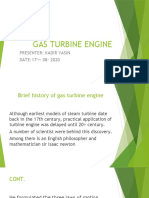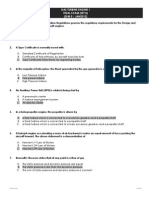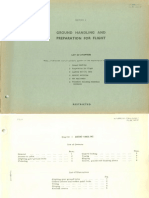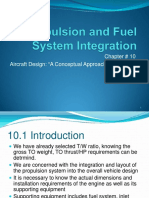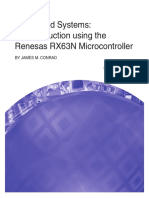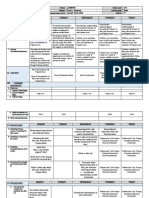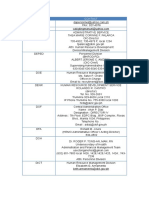0 7 PIA Module 15 (Gas Turbine Engine) Sub Module 15.7 (Exhaust)
0 7 PIA Module 15 (Gas Turbine Engine) Sub Module 15.7 (Exhaust)
Uploaded by
soophiakCopyright:
Available Formats
0 7 PIA Module 15 (Gas Turbine Engine) Sub Module 15.7 (Exhaust)
0 7 PIA Module 15 (Gas Turbine Engine) Sub Module 15.7 (Exhaust)
Uploaded by
soophiakCopyright
Available Formats
Share this document
Did you find this document useful?
Is this content inappropriate?
Copyright:
Available Formats
0 7 PIA Module 15 (Gas Turbine Engine) Sub Module 15.7 (Exhaust)
0 7 PIA Module 15 (Gas Turbine Engine) Sub Module 15.7 (Exhaust)
Uploaded by
soophiakCopyright:
Available Formats
Training Centre Module 15 – GAS TURBINE ENGINE
Category – Aerospace Sub Module 15.7 – Exhaust
MODULE 15
Sub Module 15.7
EXHAUST
ISO 9001:2008 Certified For Training Purpose Only
15.7 CAA Approval No: HQCAA/2231/44/AW Dated: 11th Sept, 09 Rev. 00
Nov 2009
Training Centre Module 15 – GAS TURBINE ENGINE
Category – Aerospace Sub Module 15.7 – Exhaust
Contents
INTRODUCTION --------------------------------------------------------------------- 1
EXHAUST GAS FLOW --------------------------------------------------------------- 1
CONSTRUCTION AND MATERIALS ---------------------------------------------- 6
EXHAUST DUCT --------------------------------------------------------------------- 7
CONVERGENT EXHAUST NOZZLE ----------------------------------------------- 8
DIVERGENT EXHAUST DUCTS ---------------------------------------------------- 8
VARIABLE AREA EXHAUST NOZZLE --------------------------------------------- 8
CONVERGENT-DIVERGENT EXHAUST NOZZLE ------------------------------10
INTRODUCTION TO THRUST REVERSER --------------------------------------12
PRINCIPLES OF OPERATION -----------------------------------------------------12
INTRODUCTION TO ENGINE NOISE--------------------------------------------17
ENGINE NOISE ----------------------------------------------------------------------17
JET EXHAUST NOISE ---------------------------------------------------------------17
COMPRESSOR AND TURBINE NOISE ------------------------------------------17
METHODS OF SUPPRESSING NOISE -------------------------------------------19
CONSTRUCTION AND METERIAL -----------------------------------------------20
ISO 9001:2008 Certified For Training Purpose Only
15.7 - i CAA Approval No: HQCAA/2231/44/AW Dated: 11th Sept, 09 Rev. 00
Nov 2009
Training Centre Module 15 – GAS TURBINE ENGINE
Category – Aerospace Sub Module 15.7 – Exhaust
ISO 9001:2008 Certified For Training Purpose Only
15.7 - ii CAA Approval No: HQCAA/2231/44/AW Dated: 11th Sept, 09 Rev. 00
Nov 2009
Training Centre Module 15 – GAS TURBINE ENGINE
Category – Aerospace Sub Module 15.7 – Exhaust
INTRODUCTION EXHAUST GAS FLOW
Aero gas turbine engines have an exhaust system which Gas from the engine turbine enters the exhaust system at
passes the turbine discharge gases to atmosphere at a velocity, velocities from 750 to 1,200 feet per second, but, because
and in the required direction, to provide the resultant thrust. The velocities of this order produce high friction losses, the speed of
velocity and pressure of the exhaust gases create the thrust in flow is decreased by diffusion. This is accomplished by having
the turbo-jet engine (but in the turbo propeller engine only a an increasing passage area between the exhaust cone and the
small amount of thrust is contributed by the exhaust gases, outer wall as shown in fig. 7-1. The cone also prevents the
because most of the energy has been absorbed by the turbine exhaust gases from flowing across the rear face of the turbine
for driving the propeller. The design of the exhaust system disc. It is usual to hold the velocity at the exhaust unit outlet to a
therefore, exerts a considerable influence on the performance of Mach number of about 0.5, i.e. approximately 950 feet per
the engine. The areas of the jet pipe and propelling or outlet second.
nozzle affect the turbine entry temperature, the mass airflow
and the velocity and pressure of the exhaust jet. Additional losses occur due to the residual whirl velocity in the
gas stream from the turbine. To reduce these losses, the turbine
The temperature of the gas entering the exhaust system is rear struts in the exhaust unit are designed to straighten out the
between 550 and 850 deg. C. according to the type of engine flow before the gases pass into the jet pipe.
and with the use of afterburning can be 1,500 deg. C. or higher.
Therefore, it is necessary to use materials and a form of The exhaust gases pass to atmosphere through the propelling
construction that will resist distortion and cracking, and prevent nozzle, which is a convergent duct, thus increasing the gas
heat conduction to the aircraft structure. velocity. In a turbojet engine, the exit velocity of the exhaust
gases is subsonic at low thrust conditions only. During most
A basic exhaust system is shown in fig. 7-1. The use of a thrust operating conditions, the exit velocity reaches the speed of
reverser noise suppressor and a two position propelling nozzle sound in relation to the exhaust gas temperature and the
entails a more complicated system as shown in fig. 7-2. The low propelling nozzle is then said to be ’choked’; that is, no further
by-pass engine may also include a mixer unit (fig. 7-4) to increase in velocity can be obtained unless the temperature is
encourage a thorough mixing of the hot and cold gas streams. increased. As the upstream total pressure is increased above
the value at which the propelling nozzle becomes ’choked’, the
static pressure of the gases at exit increases above
atmospheric
ISO 9001:2008 Certified For Training Purpose Only
15.7 - 1 CAA Approval No: HQCAA/2231/44/AW Dated: 11th Sept, 09 Rev. 00
Nov 2009
Training Centre Module 15 – GAS TURBINE ENGINE
Category – Aerospace Sub Module 15.7 – Exhaust
Fig. 7-1 a basic exhaust system.
Fig. 7-2 Exhaust systems with thrust reverser, noise
suppressor and two position propelling nozzle.
ISO 9001:2008 Certified For Training Purpose Only
15.7 - 2 CAA Approval No: HQCAA/2231/44/AW Dated: 11th Sept, 09 Rev. 00
Nov 2009
Training Centre Module 15 – GAS TURBINE ENGINE
Category – Aerospace Sub Module 15.7 – Exhaust
pressure. This pressure difference across the propelling nozzle is a possibility of the engine surging, whereas with a large
gives what is known as ’pressure thrust’ and is effective over nozzle the values obtained are too low.
the nozzle exit area. This is additional thrust to that obtained
due to the momentum change of the gas stream. A fixed area propelling nozzle is only efficient over a narrow
range of engine operating conditions. To increase this range, a
With the convergent type of nozzle wastage of energy occurs, variable area nozzle may be used. This type of nozzle is usually
since the gases leaving the exit do not expand rapidly enough automatically controlled and is designed to maintain the correct
to immediately achieve outside air pressure. Depending on the balance of pressure and temperature at all operating conditions.
aircraft flight plan, some high pressure ratio engines can with In practice, this system is seldom used as the performance gain
advantage use a convergent-divergent nozzle to recover some is offset by the increase in weight. However, with afterburning a
of the wasted energy this nozzle utilizes the pressure energy to variable area nozzle is necessary.
obtain a further increase in gas velocity and, consequently, an
increase in thrust. The by-pass engine has two gas streams to eject to
atmosphere, the cool by-pass airflow and the hot turbine
From the illustration (fig. 7-3), it will be seen that the convergent discharge gases.
section exit now becomes the throat, with the exit proper now
being at the end of the flared divergent section. When the gas In a low by-pass ratio engine, the two flows are combined by a
enters the convergent section of the nozzle, the gas velocity mixer unit (fig. 7-4) which allows the by-pass air to flow into the
increases with a corresponding fall in static pressure. turbine exhaust gas flow in a manner that ensures thorough
mixing of the two streams.
The gas velocity at the throat corresponds to the local sonic
velocity. As the gas leaves the restriction of the throat and flows In high by-pass ratio engines, the two streams are usually
into the divergent section, it progressively increases in velocity exhausted separately. The hot and cold nozzles are co-axial
towards the exit. The reaction to this further increase in and the area of each nozzle is designed to obtain maximum
momentum is a pressure force acting on the inner wall of the efficiency. However, an improvement can be made by
nozzle. A component of this force acting parallel to the
longitudinal axis of the nozzle produces the further increase in
thrust.
The propelling nozzle size is extremely important and must be
designed to obtain the correct balance of pressure, temperature
and thrust. With a small nozzle these values increase, but there
ISO 9001:2008 Certified For Training Purpose Only
15.7 - 3 CAA Approval No: HQCAA/2231/44/AW Dated: 11th Sept, 09 Rev. 00
Nov 2009
Training Centre Module 15 – GAS TURBINE ENGINE
Category – Aerospace Sub Module 15.7 – Exhaust
FIG 7-3 Gas flow through convergent divergent nozzle.
FIG 7-4 A low by-pass air mixer unit.
ISO 9001:2008 Certified For Training Purpose Only
15.7 - 4 CAA Approval No: HQCAA/2231/44/AW Dated: 11th Sept, 09 Rev. 00
Nov 2009
Training Centre Module 15 – GAS TURBINE ENGINE
Category – Aerospace Sub Module 15.7 – Exhaust
FIG 7-5 High by-pass ratio engine exhaust systems.
ISO 9001:2008 Certified For Training Purpose Only
15.7 - 5 CAA Approval No: HQCAA/2231/44/AW Dated: 11th Sept, 09 Rev. 00
Nov 2009
Training Centre Module 15 – GAS TURBINE ENGINE
Category – Aerospace Sub Module 15.7 – Exhaust
combining the two gas flows within a common, or integrated, The mixer unit used in low by-pass ratio engines consists of a
nozzle assembly. This partially mixes the gas flows prior to number of chutes through which the bypass air flows into the
ejection to atmosphere. An example of both types of high by- exhaust gases. A bonded honeycomb structure is used for the
pass exhaust system is shown in fig, 7-5. integrated nozzle assembly of high by-pass ratio engines to give
lightweight strength to this large component.
CONSTRUCTION AND MATERIALS
Due to the wide variations of temperature to which the exhaust
The exhaust system must be capable of withstanding the high system is subjected, it must be mounted and have its sections
gas temperatures and is therefore manufactured from nickel or joined together in such a manner as to allow for expansion and
titanium. It is also necessary to prevent any heat being contraction without distortion or damage.
transferred to the surrounding aircraft structure. This is achieved
by passing ventilating air around the jet pipe, or by lagging the
section of the exhaust system with an insulating blanket (fig. 7-
6). Each blanket has an inner layer of fibrous insulating material
contained by an outer skin of thin stainless steel, which is
dimpled to increase its strength. In addition, acoustically
absorbent materials are sometimes applied to the exhaust
system to reduce engine noise.
When the gas temperature is very high (for example, when
afterburning is employed), the complete jet pipe is usually of
double-wall construction with an annular space between the two
walls. The hot gases leaving the propelling nozzle induce, by
ejector action, a flow of air through the annular space of the Fig. 7-6 An insulating blanket.
engine nacelle. This flow of air cools the inner wall of the jet
pipe and acts as an insulating blanket by reducing the transfer
of heat from the inner to the outer wall.
The cone and streamline fairings in the exhaust unit are
subjected to the pressure of the exhaust gases; therefore, to
prevent any distortion, vent holes are provided to obtain a
pressure balance.
ISO 9001:2008 Certified For Training Purpose Only
15.7 - 6 CAA Approval No: HQCAA/2231/44/AW Dated: 11th Sept, 09 Rev. 00
Nov 2009
Training Centre Module 15 – GAS TURBINE ENGINE
Category – Aerospace Sub Module 15.7 – Exhaust
EXHAUST DUCT
The term exhaust duct applies to the engine exhaust pipe or tail
pipe including the jet nozzle of a non-after-burning engine
shown in Figure 7-7. Although an afterburner might also be
considered a type of exhaust duct, after burning is a subject in
itself.
If the engine exhaust gases could be discharged directly to the
outside air in an exact axial direction at the turbine exit, an
exhaust duct might not be necessary. This, however, is not
practical. A larger total thrust can be obtained from the engine if
the gases are discharged from the aircraft at a higher velocity
than that permissible at the turbine outlet. An exhaust duct is
added to collect and straighten the gas flow as it comes from the
turbine. It also increases the velocity of the gases before they
are discharged from the exhaust nozzle at the rear of the duct.
Increasing gas velocity increases its momentum and the thrust
produced.
An engine exhaust duct is often referred to as the engine tail
pipe. The engine tail cone and struts (Figure 7-7) are
usually included at the rear of the turbine. The struts support the
rear bearing and impart an axial direction to the gas flow.
The tail cone helps in smoothly converting annulus air flow in
to a solid air flow before exiting from the engine.
Figure 7-7
ISO 9001:2008 Certified For Training Purpose Only
15.7 - 7 CAA Approval No: HQCAA/2231/44/AW Dated: 11th Sept, 09 Rev. 00
Nov 2009
Training Centre Module 15 – GAS TURBINE ENGINE
Category – Aerospace Sub Module 15.7 – Exhaust
CONVERGENT EXHAUST NOZZLE
The rear opening of the exhaust duct is the jet nozzle, or exhaust
nozzle as it is often called the nozzle acts as an orifice, the size
of which determines velocity of gases as they emerge from the
engine. In most non-after-burning engines, this area is critical,
for this reason, it is fixed at the time of manufacture. The exhaust
(jet) nozzle area should not be altered in the field because any
change in the area will change both the engine performance and
the exhaust gas temperature. (Figure 7-8)
DIVERGENT EXHAUST DUCTS
Turboshaft engines in helicopters do not develop thrust using
the exhaust duct. If thrust were developed by the engine
exhaust gas, it would be impossible to maintain a stationary
hover; therefore, helicopters use divergent ducts. These ducts
reduce gas velocity and dissipate any thrust remaining in the Figure 7-8
exhaust gases. On fixed-wing aircraft, the exhaust duct may be
the convergent type, which accelerates the remaining gases to
produce thrust. This adds additional SHP to the engine rating.
Equivalent shaft horsepower (ESHP) is the combination of
thrust and SHP. (Figure 7-9)
VARIABLE AREA EXHAUST NOZZLE
Engines are equipped with variable area nozzles which are
varied the nozzle area usually automatically, with an increase or
decrease in fuel flow. The velocity of the gases within a
convergent exhaust duct is usually held to a subsonic speed.
The velocity at the nozzle approaches mach 1.0 (the velocity at
which the nozzle will choke) on turbojets and low-bypass-ratio
turbofans during most operating conditions. (Figure 7-10)
ISO 9001:2008 Certified For Training Purpose Only
15.7 - 8 CAA Approval No: HQCAA/2231/44/AW Dated: 11th Sept, 09 Rev. 00
Nov 2009
Training Centre Module 15 – GAS TURBINE ENGINE
Category – Aerospace Sub Module 15.7 – Exhaust
Figure 7-10
Figure 7-9
ISO 9001:2008 Certified For Training Purpose Only
15.7 - 9 CAA Approval No: HQCAA/2231/44/AW Dated: 11th Sept, 09 Rev. 00
Nov 2009
Training Centre Module 15 – GAS TURBINE ENGINE
Category – Aerospace Sub Module 15.7 – Exhaust
CONVERGENT-DIVERGENT EXHAUST NOZZLE velocity, particularly when a convergent nozzle is used. The
additional pressure results in additional thrust which, as has
Whenever the pressure ratio across an exhaust nozzle is high been shown, must be added when the total thrust developed by
enough to produce gas velocities which might exceed Mach 1.0 the engine is computed. The additional thrust is developed
at the engine exhaust nozzle, more thrust can be gained by inefficiently. It would be much better to convert all of the
using a convergent-divergent type of nozzle (refer back to pressure within the engine to velocity and develop the entire
Figure a). This can be done provided the weight penalty is not engine thrust by means of changes in momentum. In theory,
so great that the benefit of the additional thrust is nullified. The a C-D nozzle does this. Because it develops this additional part
advantage of a convergent-divergent nozzle (C-D nozzle) is of the total thrust more efficiently, it enables an engine to
greatest at high Mach numbers because of the resulting higher produce more total net thrust than the same basic engine would
pressure ratio across the engine nozzle. If the pressure ratio generate if it were equipped with a conventional convergent
through a subsonic exhaust duct is great enough (this will be duct and nozzle. The C-D nozzle would be nearly ideal if it
the case when the pressure at the entrance to the exhaust duct could always be operated under the exact conditions for which
becomes approximately twice that at the exhaust nozzle), the it was designed. However, if the rate of change in the duct
change in velocity through the duct will be enough to cause area is either too gradual or too rapid for the calculated
sonic velocity (Mach 1.0) at the nozzle. At very high flight Mach increase in weight of the gases, unsteady flow downstream of
numbers, the pressure ratio becomes much more than 20. If a the throat will occur with an accompanying loss of energy. This
C-D nozzle is used, the velocity at the exhaust nozzle becomes ultimately means loss of thrust. If the rate of increase in area of
correspondingly greater than Mach 1.0. This is a distinct the duct is too little, the maximum gas velocity that can be
advantage, provided the nozzle can effectively handle these reached will be limited. If the rate of increase is too great, the
high velocities. gas flow will break away from the surface of the nozzle, and the
desired increase in velocity will not be obtained. As exhaust
When a divergent duct is employed in combination with a gases accelerate or decelerate with changing engine and flight
conventional exhaust duct, it is called a convergent-divergent conditions, their pressure fluctuates above or below the
exhaust duct (Figure 7-12). In the C-D nozzle, the convergent pressure ratio for which the nozzle was designed. When this
section is designed to handle the gases while they remain occurs, the nozzle no longer converts all of the pressure to
subsonic and to deliver them to the throat of the nozzle just as velocity, and the nozzle begins to lose efficiency.
they attain sonic velocity. The divergent section handles the
gases after they emerge from the throat and become
supersonic further increasing their velocity.
Pressure generated within an engine cannot be converted to
ISO 9001:2008 Certified For Training Purpose Only
15.7 - 10 CAA Approval No: HQCAA/2231/44/AW Dated: 11th Sept, 09 Rev. 00
Nov 2009
Training Centre Module 15 – GAS TURBINE ENGINE
Category – Aerospace Sub Module 15.7 – Exhaust
The solution to this dilemma is a C-D nozzle with a variable
cross-sectional configuration which can adjust itself to changing
pressure conditions. Several types of C-D nozzles have been
tried, and a few have been used successfully on production
aircraft. As the actual design and operation of such nozzles is
usually either classified military information or proprietary
information of the manufacturer, the nozzles cannot be
described here.
ISO 9001:2008 Certified For Training Purpose Only
15.7 - 11 CAA Approval No: HQCAA/2231/44/AW Dated: 11th Sept, 09 Rev. 00
Nov 2009
Training Centre Module 15 – GAS TURBINE ENGINE
Category – Aerospace Sub Module 15.7 – Exhaust
INTRODUCTION TO THRUST REVERSER PRINCIPLES OF OPERATION
Modern aircraft brakes are very efficient but on wet, icy or snow There are several methods of obtaining reverse thrust on turbo-
covered runways this efficiency may be reduced by the loss of jet engines; three of these are shown in fig. 7-14 and explained
adhesion between the aircraft tire and the runway thus creating in the following paragraphs.
a need for an additional method of bringing the aircraft to rest
within the required distance. One method uses clamshell-type deflector doors to reverse the
exhaust gas stream and a second uses a target system with
A simple and effective way to reduce the aircraft landing run on external type doors to do the same thing. The third method used
both dry and slippery runways is to reverse the direction of the on fan engines utilizes blocker doors to reverse the cold stream
exhaust gas stream, thus using engine power as a deceleration airflow.
force. Thrust reversal has been used to reduce airspeed in flight
but it is not commonly used on modern aircraft. The difference Methods of reverse thrust selection and the safety features
in landing distances between an aircraft without reverse thrust incorporated in each system described are basically the same.
and one using reverse thrust is illustrated in fig. 7-13 A reverse thrust lever in the crew compartment is used to select
reverse thrust; the lever cannot be moved to the reverse thrust
On high by-pass ratio (fan) engines, reverse thrust action is position unless the engine is running at a low power setting, and
achieved by reversing the fan (cold stream) airflow. It is not the engine cannot be opened up to a high power setting if the
necessary to reverse the exhaust gas flow (hot stream) as the reverser fails to move into the full reverse thrust position.
majority of the engine thrust is derived from the fan. Should the operating pressure fall or fail, a mechanical lock
holds the reverser in the forward thrust position; this lock cannot
On propeller-powered aircraft, reverse thrust action is obtained be removed until the pressure is restored. Operation of the
by changing the pitch of the propeller blades. This is usually thrust reverser system is indicated in the crew compartment by
achieved by a hydro mechanical system, which changes the a series of lights.
blade angle to give the braking action under the response of the
power or throttle lever in the aircraft.
Ideally, the gas should be directed in a completely forward
direction. It is not possible, however, to achieve this, mainly for
aerodynamic reasons, and a discharge angle of approximately
45 degrees is chosen. Therefore, the effective power in reverse
thrust is proportionately less than the power in forward thrust for
the same throttle angle.
ISO 9001:2008 Certified For Training Purpose Only
15.7 - 12 CAA Approval No: HQCAA/2231/44/AW Dated: 11th Sept, 09 Rev. 00
Nov 2009
Training Centre Module 15 – GAS TURBINE ENGINE
Category – Aerospace Sub Module 15.7 – Exhaust
Figure 7-13
ISO 9001:2008 Certified For Training Purpose Only
15.7 - 13 CAA Approval No: HQCAA/2231/44/AW Dated: 11th Sept, 09 Rev. 00
Nov 2009
Training Centre Module 15 – GAS TURBINE ENGINE
Category – Aerospace Sub Module 15.7 – Exhaust
Clamshell door system In the forward thrust mode (stowed) the thrust reverser doors
form the convergent-divergent final nozzle for the engine.
The clamshell door system is a pneumatically operated system,
as shown in detail in fig. 7-14. Normal engine operation is not Cold stream reverser system
affected by the system, because the ducts through which the
exhaust gases are deflected remain closed by the doors until The cold stream reverser system (fig. 7-15) can be actuated by
reverse thrust is selected by the pilot. an air motor, the output of which is converted to mechanical
movement by a series of flexible drives, gearboxes and screw
On the selection of reverse thrust, the doors rotate to uncover jacks, or by a system incorporating hydraulic rams.
the ducts and close the normal gas stream exit. Cascade vanes
then direct the gas stream in a forward direction so that the jet When the engine is operating in forward thrust, the cold stream
thrust opposes the aircraft motion. final nozzle is ’open’ because the cascade vanes are internally
covered by the blocker doors (flaps) and externally by the
The clamshell doors are operated by pneumatic rams through movable (translating) cowl; the latter item also serves to reduce
levers that give the maximum load to the doors in the forward drag.
thrust position; this ensures effective sealing at the door edges,
so preventing gas leakage. The door bearings and operating On selection of reverse thrust, the actuation system moves the
linkage operate without lubrication at temperatures of up to 600 translating cowl rearwards and at the same time folds the
deg. C. blocker doors to blank off the cold stream final nozzle, thus
diverting the airflow through the cascade vanes.
Bucket target system
The bucket target system is hydraulically actuated and uses
bucket-type doors to reverse the hot gas stream. The thrust
reverser doors are actuated by means of a conventional
pushrod system. A single hydraulic powered actuator is
connected to a drive idler, actuating the doors through a pair of
pushrods (one for each door).
The reverser doors are kept in synchronization through the drive
idler. The hydraulic actuator incorporates a mechanical lock in
the stowed (actuator extended) position.
ISO 9001:2008 Certified For Training Purpose Only
15.7 - 14 CAA Approval No: HQCAA/2231/44/AW Dated: 11th Sept, 09 Rev. 00
Nov 2009
Training Centre Module 15 – GAS TURBINE ENGINE
Category – Aerospace Sub Module 15.7 – Exhaust
ISO 9001:2008 Certified For Training Purpose Only
15.7 - 15 CAA Approval No: HQCAA/2231/44/AW Dated: 11th Sept, 09 Rev. 00
Nov 2009
Training Centre Module 15 – GAS TURBINE ENGINE
Category – Aerospace Sub Module 15.7 – Exhaust
Figure 7-15
ISO 9001:2008 Certified For Training Purpose Only
15.7 - 16 CAA Approval No: HQCAA/2231/44/AW Dated: 11th Sept, 09 Rev. 00
Nov 2009
Training Centre Module 15 – GAS TURBINE ENGINE
Category – Aerospace Sub Module 15.7 – Exhaust
INTRODUCTION TO ENGINE NOISE created near the exhaust duct because high frequency noise
but downstream of the exhaust jet the larger eddies create low
Due to restrictions imposed by various regulatory bodies it has frequency noise. Additionally when the exhaust jet velocity
become necessary to design engines, which could be operated exceeds the local speed of sound a regular shock pattern is
within airport regulations. The unit that is commonly used to formed within the exhaust jet core. This produces a
express noise annoyance is the Effective Perceived Noise discrete tone. A reduction in noise level occurs if the mixing
decibel (EPNdB). It takes into account the pitch as well as the rate is accelerated or if the velocity of the exhaust relative to
sound pressure (deciBel) and makes allowance for the duration the atmosphere is reduced. This is normally achieved by
of an aircraft flyover figure a compares the noise levels of changing the pattern of the exhaust jet as shown in figure c.
various jet engine types.
COMPRESSOR AND TURBINE NOISE
Airframe self-generated noise is a factor in an aircraft’s overall
noise signature, but the principal noise source is the engine. Compressor and turbine noise results from the interaction of
pressure fields and turbulent wakes from rotating blades and
ENGINE NOISE stationary vanes. This can be classified under two distinct
categories. They are discrete tone (single frequency), and
To understand the problem of engine noise suppression it is broadband (a wide range of frequencies).
necessary to have a working knowledge of the noise sources
and their relative importance. The significant sources originate in The wake intensity is largely dependent upon the distance
the fan or compressor the turbine or exhaust jet or jets. These between the rows of blades and vanes. If the distance is short
increases depend on various factors. However one determining then there is an intense pressure field interaction which results in
factor is the variation in relative airflow. Exhaust jet noise varies a strong tone being generated. With the high by-pass engine the
to a greater degree than compressor or turbine noise. Therefore low pressure compressor (fan) blade wakes passing over
a reduction in exhaust jet velocity has a stronger influence than downstream vanes produce such tones but of lower intensity due
an equivalent reduction in compressor and turbine blade speeds. to lower velocities and larger blade/vane separations. Broadband
noise is produced by the reaction of each blade to the passage
JET EXHAUST NOISE of air over its surface, even with a smooth air stream. The
turbulence in the air stream passing over the blades increases
This is caused by the violent and hence extremely turbulent the intensity of the broadband noise and can also induce tones.
mixing of the turbine gases with the atmosphere and is
influenced by the shearing action caused by the relative speed
between the exhaust jet and the atmosphere. The small eddies
ISO 9001:2008 Certified For Training Purpose Only
15.7 - 17 CAA Approval No: HQCAA/2231/44/AW Dated: 11th Sept, 09 Rev. 00
Nov 2009
Training Centre Module 15 – GAS TURBINE ENGINE
Category – Aerospace Sub Module 15.7 – Exhaust
FIG 7-16
FIG 7-17
ISO 9001:2008 Certified For Training Purpose Only
15.7 - 18 CAA Approval No: HQCAA/2231/44/AW Dated: 11th Sept, 09 Rev. 00
Nov 2009
Training Centre Module 15 – GAS TURBINE ENGINE
Category – Aerospace Sub Module 15.7 – Exhaust
METHODS OF SUPPRESSING NOISE
Two basic methods are used for noise suppression.
Basic design to minimize noise originating within or propagating
from the engine and by using acoustically absorbent linings.
Reducing airflow disruption, which causes turbulence, can
minimize noise.
As previously described the major source of noise on the pure
jet engine and low by-pass engine is the exhaust jet and this can
be reduced by inducing a rapid or shorter mixing region. This
reduces low frequency noise but may increase high frequency
noise. Since high frequencies a quickly absorbed to the
atmosphere these types of noise do not dominate. A corrugated
or lobe-type noise suppressor is used to increase the contact
area by modern engines.
Deep corrugations, lobes or multi-tubes, gives the largest noise
reductions. However the performance restrictions limit the depth
FIG 7-18 of corrugations or lobes. A compromise which gives a noticeable
reduction in noise level with least sacrifice of engine thrust, fuel
consumption or addition of weight is therefore designer’s aim.
High by-pass engines inherently have a lower exhaust jet
velocity than any other type of gas turbine. This leads to a
quieter engine, but further noise reduction is desirable. The most
successful method used on by-pass engines is to mix the hot
and cold exhaust streams within the confines of the engine and
expel the lower velocity exhaust gas through flow through a
single nozzle.
ISO 9001:2008 Certified For Training Purpose Only
15.7 - 19 CAA Approval No: HQCAA/2231/44/AW Dated: 11th Sept, 09 Rev. 00
Nov 2009
Training Centre Module 15 – GAS TURBINE ENGINE
Category – Aerospace Sub Module 15.7 – Exhaust
Noise absorbing “lining” material converts acoustic energy into
heat. Methods of noise reduction are shown in figure
CONSTRUCTION AND METERIAL
The corrugated or lobe-type noise suppressor forms the exhaust
propelling nozzle and is usually a separate assembly bolted to
the jet pipe. Provision is usually made to adjust the nozzle area
so that it can be accurately calibrated. Guide vanes are fitted to
the lobe-type suppressor to prevent excessive losses by guiding
the exhaust gas smoothly through the lobes to the atmosphere.
Various noise absorbing lining materials are used on jet engines.
They fall mainly within two categories.
Lightweight composite materials that are used in lower
temperature regions. Fibrous metallic materials that are used in
the higher temperature regions.
FIG 7-19
The noise absorbing material consists of a perforated metal or
composite facing skin, supported by a honeycomb structure on a
solid backing skin which is bonded to the parent metal of the
duct or casing.
ISO 9001:2008 Certified For Training Purpose Only
15.7 - 20 CAA Approval No: HQCAA/2231/44/AW Dated: 11th Sept, 09 Rev. 00
Nov 2009
Training Centre Module 15 – GAS TURBINE ENGINE
Category – Aerospace Sub Module 15.7 – Exhaust
FIG 7-21
FIG 7-20
ISO 9001:2008 Certified For Training Purpose Only
15.7 - 21 CAA Approval No: HQCAA/2231/44/AW Dated: 11th Sept, 09 Rev. 00
Nov 2009
Training Centre Module 15 – GAS TURBINE ENGINE
Category – Aerospace Sub Module 15.7 – Exhaust
FIG 7-22
ISO 9001:2008 Certified For Training Purpose Only
15.7 - 22 CAA Approval No: HQCAA/2231/44/AW Dated: 11th Sept, 09 Rev. 00
Nov 2009
You might also like
- AnswersDocument21 pagesAnswersAman PrasadNo ratings yet
- Spartan Atb 8083 30a Gen WorkbookDocument114 pagesSpartan Atb 8083 30a Gen WorkbookTEACHA WONG100% (1)
- CAIP Vol II PropellersDocument32 pagesCAIP Vol II PropellersSHM 555No ratings yet
- Ducted Prop For STOL PaperDocument8 pagesDucted Prop For STOL PaperLEADANo ratings yet
- NASA Small Aircraft Gust LoadsDocument12 pagesNASA Small Aircraft Gust LoadsRichard MayNo ratings yet
- Reliance Money Project ReportDocument75 pagesReliance Money Project ReportPardeep Sharma SNo ratings yet
- 2 - LOGIC GATES - Revision Worksheet MS - CoachingDocument22 pages2 - LOGIC GATES - Revision Worksheet MS - CoachingAfaf ShahidNo ratings yet
- "Abhyas": Propulsion System For Abhyas - Single BoosterDocument15 pages"Abhyas": Propulsion System For Abhyas - Single BoosterChristina WheelerNo ratings yet
- Sub Module 13.1 Theory of FlightDocument56 pagesSub Module 13.1 Theory of FlightteacherNo ratings yet
- 20fire 1Document28 pages20fire 1Hemantkumar TungNo ratings yet
- Sub Module 13.1 Theory of FlightDocument53 pagesSub Module 13.1 Theory of FlightAhsan Malik100% (1)
- Design and Development of An Air Intake For A Supersonic Transport Aircraft.Document9 pagesDesign and Development of An Air Intake For A Supersonic Transport Aircraft.Mihai ClaudiuNo ratings yet
- Module 15 Books PDFDocument1 pageModule 15 Books PDFajaydce05100% (1)
- Complete New U Grad Track in AviationDocument144 pagesComplete New U Grad Track in Aviationavcs1No ratings yet
- klmB1 Mod 11.17Document27 pagesklmB1 Mod 11.17andrinjoNo ratings yet
- The Rolls-Royce Trent Engine: Michael CervenkaDocument40 pagesThe Rolls-Royce Trent Engine: Michael CervenkagoharNo ratings yet
- Aa 02015Document181 pagesAa 02015pepefloresx2013No ratings yet
- Duracell Ultra SLA General Purpose Product Sheet ID3713Document2 pagesDuracell Ultra SLA General Purpose Product Sheet ID3713Caja FuegoNo ratings yet
- Compressors & TurbinesDocument44 pagesCompressors & Turbinesdlpk311No ratings yet
- PK-ANQ - Related SB Sundowner C23 - TPU 13Document3 pagesPK-ANQ - Related SB Sundowner C23 - TPU 13Rivaldo Alfaridzki AviadiNo ratings yet
- Paper 2002 Reduced Thrust TakeoffDocument4 pagesPaper 2002 Reduced Thrust TakeoffjuanNo ratings yet
- Module 17 FundamentalsDocument25 pagesModule 17 FundamentalsChrisZoepoundNo ratings yet
- Exhaust: Gas Turbine Engine B1 Category Lesson 07 ExhaustDocument61 pagesExhaust: Gas Turbine Engine B1 Category Lesson 07 Exhaustraul yondo100% (1)
- Module 9 (Human Factors) Sub Module 9.7 (Communication) - RevDocument13 pagesModule 9 (Human Factors) Sub Module 9.7 (Communication) - RevInterogator5No ratings yet
- Type Acceptance Report: Piper PA-30 and PA-39Document9 pagesType Acceptance Report: Piper PA-30 and PA-39Naco SanchezNo ratings yet
- Gas Turbine EngineDocument32 pagesGas Turbine EngineMUHOOZI DENISNo ratings yet
- Modul 9 KaynakDocument198 pagesModul 9 Kaynakdemirgorkem34fbNo ratings yet
- Aerospace Recommended Practice: InternationalDocument25 pagesAerospace Recommended Practice: InternationalAndrei_TestiNo ratings yet
- Airworthiness Directive Schedule: Aeroplanes Hawker Beechcraft Corporation C90A, C90Gt and C90Gti 27 May 2010Document17 pagesAirworthiness Directive Schedule: Aeroplanes Hawker Beechcraft Corporation C90A, C90Gt and C90Gti 27 May 2010midun100% (1)
- Section 13D - Engine Air System PDFDocument6 pagesSection 13D - Engine Air System PDFrobbertmdNo ratings yet
- 412-MD-04-S02 Handling and ServicingDocument18 pages412-MD-04-S02 Handling and ServicingJhoann Miguel Galvan SarabiaNo ratings yet
- Diffuser Selection in Centrifugal CompressorsDocument6 pagesDiffuser Selection in Centrifugal Compressorsmick.pride81No ratings yet
- CNG LNG RegulationsDocument142 pagesCNG LNG RegulationsAkano OluwasolaNo ratings yet
- Training Manual: EASA Part-66 54 Level 3Document10 pagesTraining Manual: EASA Part-66 54 Level 3Luis Enrique La Font FrancoNo ratings yet
- Airframe QuestionsDocument41 pagesAirframe QuestionsJDany Rincon Rojas100% (1)
- Fly by Wire and Fly by OpticsDocument7 pagesFly by Wire and Fly by OpticsvenkatsahulNo ratings yet
- Manual de ServiciosDocument863 pagesManual de ServiciosPiero RamírezNo ratings yet
- Pressurization System: Developed For Training PurposesDocument14 pagesPressurization System: Developed For Training PurposesJuan Garcia SanchezNo ratings yet
- 2024.02.29 FTS-R FinalDocument160 pages2024.02.29 FTS-R FinalPatpong ThaweekulNo ratings yet
- Performance Analysis of NACA4412 Airfoil With Gurney Flap: February 2020Document9 pagesPerformance Analysis of NACA4412 Airfoil With Gurney Flap: February 2020Marek PawelNo ratings yet
- Combustion Chamber PDFDocument2 pagesCombustion Chamber PDFSusan0% (1)
- A4 Fuel Metering System - Muhammadh Maihan Nazim - 6bme1 - 53211219102Document4 pagesA4 Fuel Metering System - Muhammadh Maihan Nazim - 6bme1 - 53211219102Musabbir IslamNo ratings yet
- Lycoming T53Document3 pagesLycoming T53cecil josef liganNo ratings yet
- AIRCRAFT DESIGN 2 Report 1 Flight Envelope. VN Diagram Rev2 2Document12 pagesAIRCRAFT DESIGN 2 Report 1 Flight Envelope. VN Diagram Rev2 2anthony momoNo ratings yet
- AMAeSI Syllabus1 PDFDocument85 pagesAMAeSI Syllabus1 PDFSuhas Kande0% (1)
- 407 MM CH08Document8 pages407 MM CH08Ricardo zafraNo ratings yet
- M15-Gas Turbine Engine-WatermarkDocument172 pagesM15-Gas Turbine Engine-WatermarkvalNo ratings yet
- Turbine1 FinalDocument7 pagesTurbine1 Finalmohd shahir100% (2)
- CFD A A D T TU-154M P: Ssessment of Erodynamic Egradation of HE LaneDocument8 pagesCFD A A D T TU-154M P: Ssessment of Erodynamic Egradation of HE LaneAlexander NenovNo ratings yet
- Airworthiness Advisory Circular: AAC No. 2 of 2018Document51 pagesAirworthiness Advisory Circular: AAC No. 2 of 2018Gaurav SinghNo ratings yet
- Module 15 Gas Turbine Engine Compress (001 100)Document100 pagesModule 15 Gas Turbine Engine Compress (001 100)ggg594768100% (1)
- Return To TOC: Dowty Propellers Standard Practices ManualDocument4 pagesReturn To TOC: Dowty Propellers Standard Practices ManualNicolás PiratovaNo ratings yet
- T11, Section 2, Ground HandlingDocument52 pagesT11, Section 2, Ground HandlingDavid WongNo ratings yet
- Robinson Series 22 - 44Document39 pagesRobinson Series 22 - 44Oscar Arias100% (1)
- Propulsion and Fuel System IntegrationDocument36 pagesPropulsion and Fuel System IntegrationNouman Nadeem0% (1)
- The EASA Part 66 LicenceDocument6 pagesThe EASA Part 66 LicenceখালিদহাসানNo ratings yet
- M5 Selected PagesDocument52 pagesM5 Selected PagesИлларион ПанасенкоNo ratings yet
- L2 11.2.1 Airframe Structures - General (International) A-1Document14 pagesL2 11.2.1 Airframe Structures - General (International) A-1mohan reddyNo ratings yet
- Dgca Module 06 Part 04Document14 pagesDgca Module 06 Part 04SatyamNo ratings yet
- 100 Years of Vortex Theory PDFDocument25 pages100 Years of Vortex Theory PDFManuel ZúñigaNo ratings yet
- PTC B1.1 Notes - Sub Module 15.5 (Combustion Section)Document19 pagesPTC B1.1 Notes - Sub Module 15.5 (Combustion Section)Interogator5No ratings yet
- PTC B1.1 Notes - Sub Module 15.12 (Air Systems)Document27 pagesPTC B1.1 Notes - Sub Module 15.12 (Air Systems)sohail aviatorNo ratings yet
- DCAM PT 66 TRAINING MODULE 15.7 ExhaustDocument52 pagesDCAM PT 66 TRAINING MODULE 15.7 ExhaustSThaneasMurNo ratings yet
- Linearization Approach For Modeling Power Electronics Devices in Power SystemDocument10 pagesLinearization Approach For Modeling Power Electronics Devices in Power SystemKalyan Reddy AnuguNo ratings yet
- PVElite 2013 ManualDocument517 pagesPVElite 2013 ManualAnonymous UoHUag100% (1)
- MANITOU MT 1840 - Tier 4Document4 pagesMANITOU MT 1840 - Tier 4Anton LazarovNo ratings yet
- Certificate - Khalilah Husna Yenofitri - Exploring Economics - The Secret Life of T-ShirtsDocument2 pagesCertificate - Khalilah Husna Yenofitri - Exploring Economics - The Secret Life of T-Shirtskhalilah.yenofitriNo ratings yet
- Databsecse 301Document6 pagesDatabsecse 301Rohit PareekNo ratings yet
- 3 Assignment of ACCT-301Document3 pages3 Assignment of ACCT-301Tina Bhambbhwani0% (1)
- Doj Opinion No. 44 (1990)Document4 pagesDoj Opinion No. 44 (1990)lyragae_israel100% (2)
- Digital PhotographyDocument24 pagesDigital PhotographyTrickDaddy112100% (1)
- Document 2Document22 pagesDocument 2diekbluesNo ratings yet
- Definition:: Electrical Panel & Types of Electrical PanelsDocument13 pagesDefinition:: Electrical Panel & Types of Electrical PanelsDesign Power Tech TransformersNo ratings yet
- The Importance of MediaDocument2 pagesThe Importance of MediaPatrick AlejandroNo ratings yet
- Msih Student-To-Student Guide 2018 Section 1Document26 pagesMsih Student-To-Student Guide 2018 Section 1api-426256871No ratings yet
- ES RX63N Reprint Soft Proof 2013-09-30Document468 pagesES RX63N Reprint Soft Proof 2013-09-30Felipe NavarroNo ratings yet
- 32362-04A Spark Plug, 6R12 25PcsDocument2 pages32362-04A Spark Plug, 6R12 25PcsFebri MaulanaNo ratings yet
- DLL in Music 2nd Quarter Jan 16 20Document3 pagesDLL in Music 2nd Quarter Jan 16 20Rocel DesaculaNo ratings yet
- Disclosure To Promote The Right To Information: IS 5290 (1993) : Specification For Landing Valves (CED 22: Fire Fighting)Document20 pagesDisclosure To Promote The Right To Information: IS 5290 (1993) : Specification For Landing Valves (CED 22: Fire Fighting)Tanmoy Dutta100% (1)
- Immunoscreening and Construction of CDNA LibraryDocument18 pagesImmunoscreening and Construction of CDNA LibraryBhavya ThakuriaNo ratings yet
- Fin Irjmets1665138841Document5 pagesFin Irjmets1665138841AlikhanNo ratings yet
- Wedding PDFDocument14 pagesWedding PDFNataly TembikovskaNo ratings yet
- Tiktok Challenge 5 4-3 2-1 ScoreDocument1 pageTiktok Challenge 5 4-3 2-1 ScoreVhon Joseph Solomon LptNo ratings yet
- Human Resource OfficesDocument3 pagesHuman Resource OfficesMa Krishina Joy Amigo - EscobarNo ratings yet
- The Link Between SD and MMDocument3 pagesThe Link Between SD and MMSuneetha MathukumalliNo ratings yet
- Standard Classroom Building - DPWH As of 021524 A1Document1 pageStandard Classroom Building - DPWH As of 021524 A1designers.starlightNo ratings yet
- Blowout BeddingDocument4 pagesBlowout BeddingblowoutbeddingNo ratings yet
- Correct Answers Are Shown in - Attempted Answers, If Wrong, Are inDocument14 pagesCorrect Answers Are Shown in - Attempted Answers, If Wrong, Are inbharatNo ratings yet
- IITM BSC Data ScienceDocument26 pagesIITM BSC Data Scienceshadowchaser9910No ratings yet
- XATS 156 DD: Parts List For Portable CompressorsDocument132 pagesXATS 156 DD: Parts List For Portable Compressorsdavid perezNo ratings yet

























